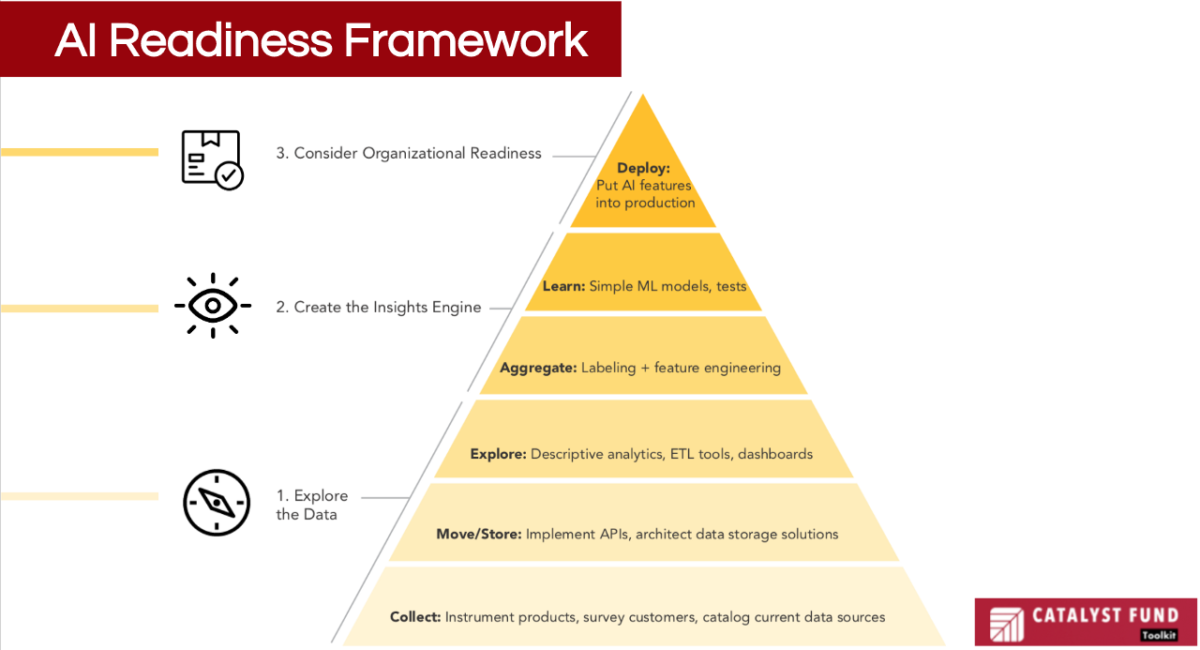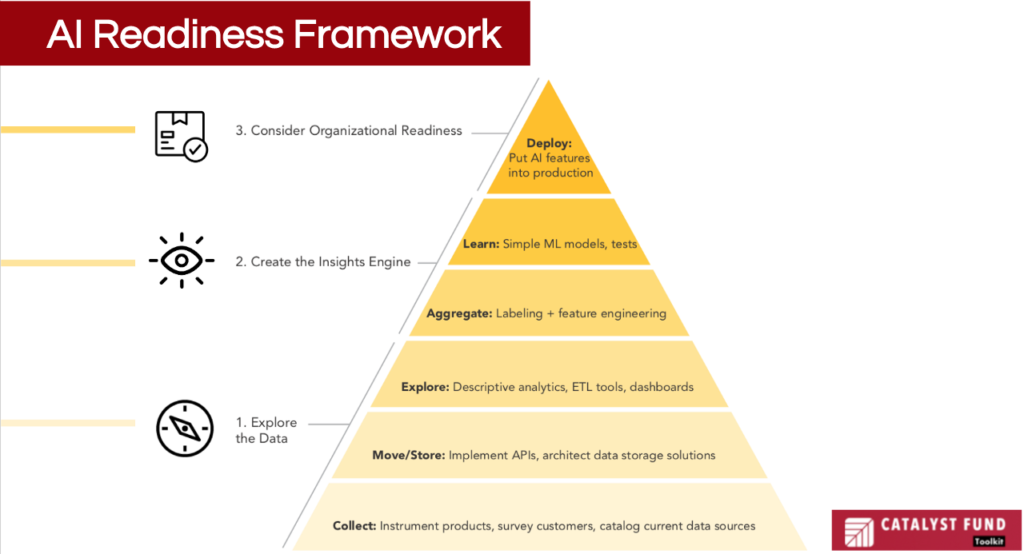Six Steps to an Intelligent AI Strategy: The AI Readiness Toolkit


Are you a startup seeking to prepare yourself for artificial intelligence (AI), but don’t yet have a concrete strategy in place? Perhaps you are a well-established data-centric organization that wants to assess return on investment and areas of strength and weakness. Or you are an investor looking for a way to quantitatively assess your portfolio. Catalyst Fund’s new AI Readiness Toolkit can help you.
Seemingly, everyone has something to say about the abundance of data, and the potential of AI to harness them. However, for most organizations, including startups, reality lags far behind these lofty statements and leadership is frequently left drowning in data while still thirsting for insights.
BFA is determined to de-hype AI and bring it into practical terms so that more startups can benefit from its power. To this end, we have developed the AI Readiness Toolkit to guide startups to approaching AI in a systematic way. This toolkit builds on BFA’s “AI: Practical Superpowers” Report, which gives startups a high-level readiness framework to orient on the step to take towards “Practical AI”:

Leadership is frequently left drowning in data while still thirsting for insights.
With this hierarchical framework in hand, startups need to decide what to do next to build an AI strategy for their institution. These considerations must include a thorough evaluation across several dimensions:
- Do I need to generate more data, clean the data I already have, store it more effectively?
- Have I built the right team, and trained and incentivized it appropriately?
- Do I need to invest in additional technical tools or infrastructure, and which ones should I prioritize?
Based on our experience with Catalyst Fund’s four cohorts, we have found that AI tools — when fed the right data, supported by the right team, and deployed carefully — can sharpen internal management and operations processes, and enhance products and services by improving speed, cost, and accuracy.
The AI Readiness Toolkit replaces what is traditionally a binary “go/no-go” decision with a series of more granular insights, including actionable recommendations and resources to augment growth.
Introducing the AI Readiness Toolkit
Building on several similarly-minded initiatives, including a “Data Maturity Framework” presented by the University of Chicago’s Data Science for Social Good program, the AI Readiness Toolkit focuses on six main dimensions of readiness:
- Defining the real-world problem that AI can help to address,
- Leveraging the right technologies and best practices,
- Optimizing operations and developing a strong team,
- Generating and processing the right data,
- Assessing return on investment, and
- Other considerations such as evaluating buy-in from key stakeholders.
Step 1: Complete the Multi-Dimensional Questionnaire
The first step of the toolkit is a questionnaire to evaluate six dimensions laid out above. Aided by examples and detailed descriptions for each score, and informed by discussions with the appropriate stakeholders in your organization, you begin your journey by scoring each question and providing more qualitative responses for additional color. For example, in assessing data collection, aggregation, and storage the toolkit presents several options:
Step 2: Your Place on the AI Readiness Index
Based on your answers to the questionnaire, your startup is presented with a baseline score on the AI Readiness Index as well as a description of what that score means. This quantitative representation of your current readiness, also based on a scale of 1–5, can be used to:
- Gauge progress towards readiness over time. The toolkit assesses ROI to see how each additional feature or product improvement is likely to advance overall AI readiness relative to other roadmap items. Results are also stored in-browser, so the toolkit can be revisited after improvements have been made to reassess and evaluate progress.
- Compare to other companies. A startup can use this to highlight competitive advantage, while potential or current investors can assess where to infuse capital, and use scores to compare baseline progress across a portfolio of companies.
Step 3: Identify Key Areas for Improvement
The Readiness Index score is a high-level benchmark. The next section of the toolkit goes one step deeper, and recommends three areas for improvement for your startup. These areas are identified based on an algorithmic processing of the responses to the questionnaire, as well as heuristics from our experience across the Catalyst Fund. For instance, a company needing to focus on improving collection and digestion of data may see the following results:
Step 4: Utilize Recommended Resources
Finally, the Toolkit provides granular recommendations on how to improve readiness on each of the dimensions. The recommendations are hyperlinked to external resources that our Catalyst Fund partners have found useful on their AI journeys. Review and internalize these resources to prepare to adopt AI, and return to the assessment at regular intervals to see your improvements reflected quantitatively.

We’re Here to Iterate, Iterate, Iterate!
The first version the AI Readiness Toolkit was launched in October 2018 at SOCAP18, but as we often repeat when coaching our startups — it isn’t finished! We believe it is critical to put a product out to the users and let them decide whether it’s complete. So try out the toolkit and give us feedback on what’s worked and what hasn’t, reach out with any questions, comments or feedback you might have, and help us to improve it!


